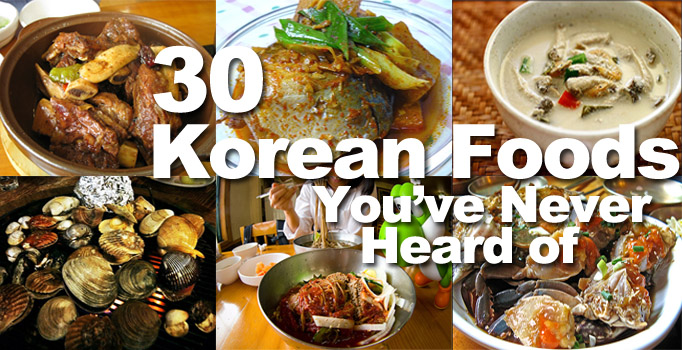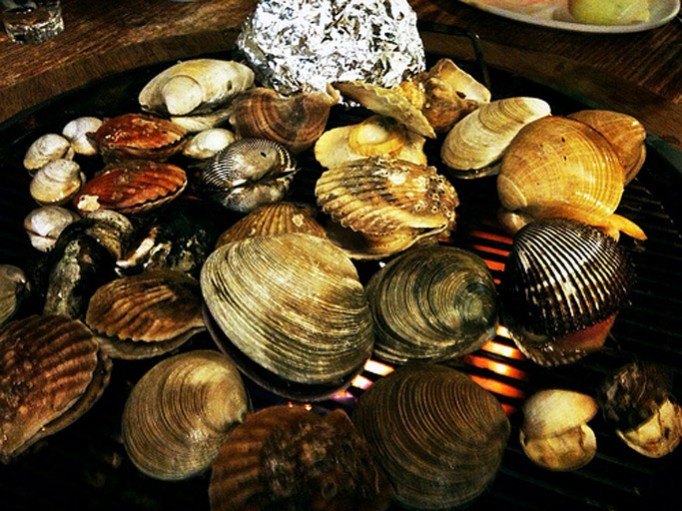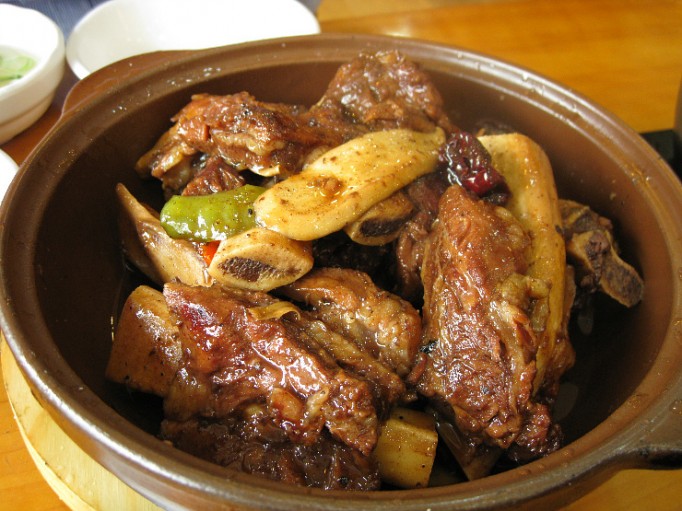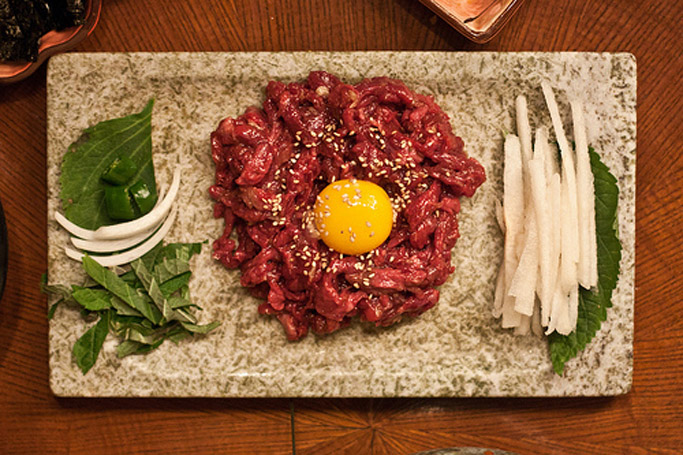30 Delicious Korean Foods You’ve (Probably) Never Heard Of
- agujjim
- altang
- andongjjimdalk
- bossam
- cheonggukjang
- daechanggui
- deulkketang
- galbi jjim
- galchijorim
- gamjaguk
- gamjatang
- ganjanggejang
- godeungeojorim
- golbaengi muchim
- gopchanggui
- gyeranjjim
- gyeranmari
- hobakjuk
- hoedeopbap
- jangjorim
- jjimdalk
- jjolmyeon
- jogaegui
- kimchimari guksu
- kongguksu
- kongnamulguk
- list of korean food
- maeuntang
- makguksu
- miyeokguk
- muguk
- nurungjitang
- someorigukbap
- suyuk
- where to eat in seoul
- yukhoe


Korean food is globalizing quickly, and most menus at Korean restaurants outside of Korea are usually filled with galbi, naengmyun, bibimbap, kimchi jjigae and the same dozen other options that everyone knows. Of course they’re delicious, but Korean food has so much more than that. Here’s a list of Korean foods that most people have never heard about but should definitely try!
Note 1: Of course everyone’s knowledge of Korean food is different. This post is meant for those whose Korean food experience is limited to the all stars of Korean food cuisine (galbi, bulgogi, naengmyun, bibimbap, tteokbokki, etc.). Although those are the most popular for a reason, we want to highlight a few not-as-popular, but just-as-delicious Korean foods you have to try when you come visit Korea.
Note 2: There’s hundreds (thousands?) of Korean foods that can be placed on this list. But here’s a quick list of 30 to get you started on your Korean food journey 🙂
Korean BBQs & Meats
1. Galbijjim (갈비찜) – braised short rib – You all should know galbi, but galbijjim is a galbi variation that isn’t so easy to get simply because it takes longer and more effort to make. And although it’s not grilled, don’t worry, it’s just as delicious as galbi (maybe even better!). This is a guaranteed instant favorite. We are very serious. Instant. Favorite. Check out Seoulistic’s post for 10 Best Galbi restaurant in Seoul, and see the galbijjim entries.
2. Gopchang Gui(곱창구이) & Daechang Gui (대창구이) – grilled intestines – You all know Korean BBQ, but as some people think intestines are gross, you probably haven’t heard of this one. Although you might think Korean BBQ is just galbi and samgyupsal, gopchang and daechang are two Korean BBQ dishes that are chewy, fatty, and ultra delicious. If you like galbi, definitely give this a try. Not sure where to go? Try hongdae’s Gopchang alley (see this google map). (Click here for image)
 3. Jogaegui (조개구이) – grilled shellfish – Meats get the most coverage of the Korean BBQs, but sometimes you just need some good ol’ loving from the sea. Sit down at a Korean BBQ pit and dump a bunch of shelled goodies on the grill and wait for them to crack open on their own. When they’re ready, start digging in. Oh, and don’t forget to slurp up the juices in the open shells. Mmmm, saltwater goodness! Best eaten near the East Sea, but still delicious at all places Korea 🙂
3. Jogaegui (조개구이) – grilled shellfish – Meats get the most coverage of the Korean BBQs, but sometimes you just need some good ol’ loving from the sea. Sit down at a Korean BBQ pit and dump a bunch of shelled goodies on the grill and wait for them to crack open on their own. When they’re ready, start digging in. Oh, and don’t forget to slurp up the juices in the open shells. Mmmm, saltwater goodness! Best eaten near the East Sea, but still delicious at all places Korea 🙂
4. Andong Jjimdalk (안동 찜닭) – steamed marinated chicken – Rumored to be the anti Korean fried chicken, Andong jjimdalk is a Korean chicken dish that will have you craving non-fried Korean style chicken. With big ol’ pieces of chicken (non-fried of course), glass noodles, potatoes, carrots and other vegetables, this undoubtedly has a very Korean taste. Go to Andong if you can (obviously!), but Andong jjimdalk restaurants can still be found all over Korea. (Click here for image)
5. Bossam (보쌈) & Suyuk (수육) – braised pork loins – This slow-cooked, ultra tender version of samgyupsal is commonly found in Korea at big ol buffets, like the ones you’ll find at doljanchis. But this is also a very delivery-friendly food that is delivered to all parts of Korea. If you’re a carnivorous Korean food enthusiasts and not a fan of making your clothes smell like Korean bbq all day long, this is an excellent alternative. And you’ll get a special kind of kimchi with any order of bossam (not suyuk). Grab a take-out food booklet (or ask your hotel for one). Bossam restaurants deliver to all parts Korea. (Click here for image)
6. Yukhoe (육회) – raw beef slices (aka steak tartare) – Some people are freaked out by eating slices of raw beef, but worry not; this is a safe and delicious Korean food to eat. Sometimes it’s a dish just on its own, and sometimes it’s used as a topping for bibimbap. It can get a bit pricy though as the most tender parts of the beef are used. Give this Korean delicacy a try and discover a new item to add to your list of must eat Korean foods!
→ Next Page







29 Comments
Actually gamjatang is not potato stew. Gamja stands for the cut of the meat not the potato itself.
Jesse that is incorrect, gamja means potato in korean, and tang means soup in korean. so gamja tang is appropriately potato soup/stew. please do not spread misinformation like that.
You’re right but, there is a theory you didn’t know.
Pig’s backbones, one of the main ingredient of ‘gamjatang’, was called ‘gamjappyeo’ or ‘gamjeo(甘猪)’ in the past. As you know, ‘gamjappyeo’ and ‘gamjeo’ are similar with ‘gamja’ in their pronunciation.
Han and Jesse are right. The original gamja tang did not contain potatoes and some places still don’t use potatoes.
Actually I knew of all of them. My favorite is gamjatang
http://www.youtube.com/watch?v=ejW_UtYdSss
Actually what Jesse said is true. The cut of the meat is actually called kamja. lol.
I am fluent in Korean and I am dating a Korean (3 years).
Ask a korean if you are not sure
Also, you can get kamjatang without potato in it =)
… Also it’s not 덥밥, it;s 덮밥. Sorry!
… 누룽지^ ㅠㅠ
You are correct! Edited to reflect your corrections. Thanks everyone! 🙂
It feels good to know that I have eaten as well as made majority of these delicious Korean food at home. Korean food is very healthy and because of that, I am able to maintain my top physical shape. ^^
Nice Chris, glad it’s keeping you healthy! You’re a K-food expert 🙂
http://lmgtfy.com/?q=%EA%B0%90%EC%9E%90
Erica, try again.
The 감자 in 감자탕 refers to the 감자뼈, which is the cut of meat that is in the dish. @J: Try again, look up 감자뼈.
Jesse, all you did was replace the word soup with the word bone. There are both potato (usually), and bone in that soup. This seems like a common misconception, and probably was the way it has been called for years (with or without the potato). (Much like how ramen means pulled noodles, even though they are rarely hand pulled now.) Though that doesn’t mean it is correct. In fact I went to eat this the other day and specifically asked the lady this question, she said gamja means potato. It doesn’t get much clearer than that.
Here’s another example: gamja jorim. Guess what? gamja is potato, and jorim is the cooking/prep method. Are you telling me gamja jorim is actually some sort of bone side dish? Seems like it isn’t.
The facts are that gamja means potato, and i’m not seeing any exception. Maybe there is an exception, but you haven’t show me. Please show me otherwise. Also, yes I can read korean.
Actually historians disagree on whether the 감자 in 감자탕 refers to potatoes or a particular part of the pig. So both theories could be true.
J, you do know that words can have several meanings, right? ^^ The most common meaning of 감자 is potato, but the part of the pig that is used in 감자탕 is commonly referred to as 감자뼈. Whether it was always called 감자뼈 is something historians can’t agree on. Some think that it took on the name 감자뼈 because it was always being used in 감자탕. No one knows for sure.
I am a Korean native speaker, for what it’s worth.
Yea I understand. I speak chinese as well and we often have simliar words/phrases, that can mean completely unrelated things, or the once-used-for-this-situation-now-always-used-regardless-of-logic words/phrases.
I guess calling it a potato bone because it’s commonly used in that dish seems pretty reasonable. I just hope people know that the actual bone used isn’t a “potato bone” but the 등뼈, and occasionally the 무릎뼈 and possibly others depending on the shop. The shop I frequent uses a lot of 무릎뼈.
I always eat the italian version of (육회) , carppaccio. I loove raw beef
korean usually eat page 3. #12 Makguksu (막국수) after eating Dakgalbi(Spicy Grilled Chicken) as main meal !! <3 so delicious ^.^
Why does Korean still eat raw beef? Japanese use to eat raw beef but then people die from eating it. The raw beef in Japan got ban for having on the menu. There no cure for raw beef if you get sick or about to die.
I feel so hungry now.. ^^
btw there are some mistakes. 김치마리국수 -> 김치말이국수, and 계란마리 -> 계란말이.
one question: What am I supposed to do, when I get a soup and one bowl of rice? I mean, shoud I put the rice into the soup, stir it ad then eat, or eat one spoon of the soup and then rice, one spoon of the soup and again rice?
hi guys, big fan of Seoulistic.com … recently saw a popular singapore blogger copying THIS PARTICULAR article wholesale without crediting. not sure what i should do, so just letting you know.
Hi thanks for letting me know! If you could email at [email protected] the specific blog. I don’t mind reposting, but would like to kindly ask for crediting 🙂
육회 너무 맛있어 보인다!!!
hmm I have heard off some off these and i love Yukhoe, sometimes at school i’ll just by raw beef and eat that during my lunchbreak even though my friends can’t stand it (most of them are vegans)lol
j, jessie, Shut up!!
Is it strange that I know all of these? They aren’t too uncommon.
Can someone please explain what the GAMJA means in GAMJAtang. It is still very unclear to me what this soup consist of. Maybe ask J and Jessie to help again? Ps. I am an English native speaker if that helps. Thanks ㅜㅜ ㅎㅎㅎㅎㅎ lolol